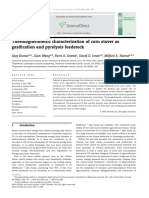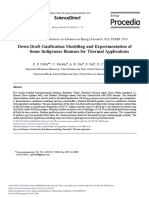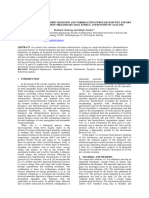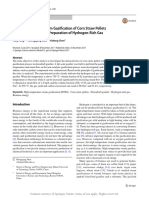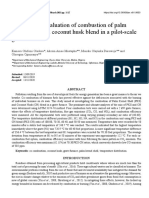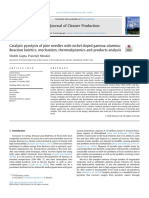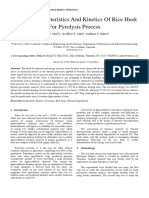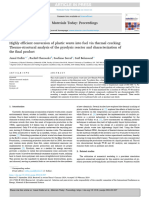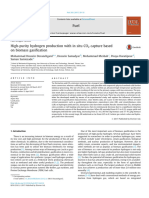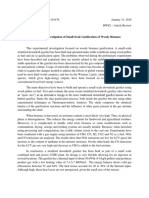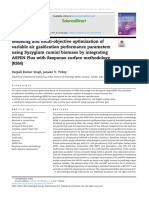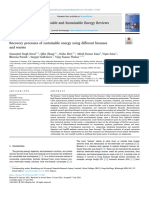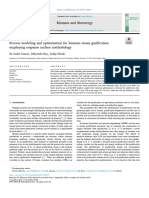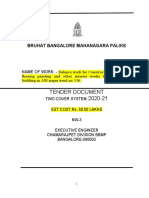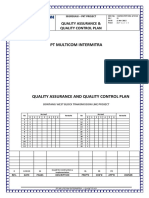Ijett V65P228
Ijett V65P228
Uploaded by
patoskiCopyright:
Available Formats
Ijett V65P228
Ijett V65P228
Uploaded by
patoskiOriginal Title
Copyright
Available Formats
Share this document
Did you find this document useful?
Is this content inappropriate?
Copyright:
Available Formats
Ijett V65P228
Ijett V65P228
Uploaded by
patoskiCopyright:
Available Formats
International Journal of Engineering Trends and Technology (IJETT) – Volume 65 Number 3 - November 2018
Analysis of Process Parameters on the Biomass
Gasification Using Response Surface
Methodology
M. Senthil Kumar
Assistant Professor, Department Of Mechanical Engineering, Annamalai University,
(Deputed to GPTC Dharmapuri) Chidambaram-608002, Tamil Nadu, India.
Abstract recovery of energy is wood powder because of its
This paper is to study the effect of design and reasonably high energy content (12–18 MJ/kg) [1].
operating parameters, mainly as bed temperature (T), The efficient conversion of solid biomass into high
pressure (P), equivalence ratio(R), feed rate (F) and quality product gas from fluidized bed gasifier. The
particle size (S) on the performance of the gasification process is currently performed on wood chips from
process of wood powder as biomass in a updraft natural sources. In addition to biomass from forestry,
reactor. In the present investigation, an empirical woody residues, such as bark, waste wood, and sawdust
relationship was developed to predict the process of are interesting feedstock because of their availability
generating producer gas with better quality through and price. The particle size of the biomass has an
gasification of biomass in a fluidized bed reactor using important influence on its thermal conversion and this
response surface methodology (RSM). The producer has been studied by several research groups. It is
gas component such as O2, H2, CO, CO2, CH4, and N2 commonly agreed on that the particle size determines
were analyzed in the laboratory along with the the mass and heat transfer into and from the particle.
evaluation of tar yield and cold gas efficiency. It was Four different regimes of heat transfer are distinguished
observed that the concentrations of hydrogen, oxygen related to particle size: In the kinetic regime, particles
nitrogen and carbon monoxide were increased with rise are considered to be isothermal and to heat up instantly.
in gasification temperature, pressure and equivalent In the thermally thin regime, external heat transfer
ratio (0.2-0.35). Higher equivalence ratios (0.4-0.5) occurs between the particle and the surroundings, but
caused to decrease the concentrations of hydrogen, the intra-particle temperature gradient is found to be
oxygen, nitrogen and carbon monoxide. Higher negligible. In the thermally thick regime, the reactions
equivalence ratio also resulted in more gas yields and of the particles are controlled by external and internal
cold gas efficiency due to increase in the exothermic heat transfer [2]. The gasification technologies are
reactions. Furthermore, it was observed that the CH4 broadly of two types – fixed bed and fluidized bed.
and CO2 decreased with the increase of temperature According to Ergudenler [3], the fluidized bed
and pressure. The developed model was made a good technology offers great advantages when used for
prediction. gasifying low density biomass residues to generate low
calorific value fuel gas. The conventional types of
Keyword - wood powder, Producer gas, Fluidized bed gasifiers are not suitable for conversion of wood
gasifier, Equivalent ratio and Response surface powder because of its high ash content, low bulk
methodology. density, poor flow characteristics and low ash melting
point. The fluidized bed gasifier seems to be the
Highlights suitable option for such conversion with better control
An empirical relationship developed to predict of bed temperature in isothermal conditions. The
the quality of the producer gas countries are rapidly moving forward with developing
Response surface methodology (RSM) was and deploying biochemical technology, using the
used. sugarcane and the corn. Sugar cane ethanol is generally
regarded as having little to no impact on primary food
The developed model was made a good supplies and prices.However, food supply and price
prediction for the experimental data. concerns have been raised about corn ethanol
production [4] because corn grain is an important food
I. INTRODCTION and animal feed commodity. The EU, the largest
biodiesel producer, uses rapeseed oil as its main
Renewable resource is essential to secure the energy feedstock and again concerns about fats and oils
. An agricultural residue that could be utilized for the
ISSN: 2231-5381 http://www.ijettjournal.org Page 155
International Journal of Engineering Trends and Technology (IJETT) – Volume 65 Number 3 - November 2018
supplies and prices have been raised over the diversion II. EXPERIMENTAL WORK
of rapeseed oil to biodiesel production. second
generation biofuels technologies will be required to A. Inert bed materials and Feedstock
meet aggressive volume goals for biofuels deployment To study the fluidized bed gasification and feed
[5]. A number of different conversion technologies stock wood powder selected with different granular
exist [6, 7] for the conversion of cellulosic biomass to sizes. These biomaterials were collected from rural
biofuels. The predominant differentiation between the industries of Cuddalore district, India. The proximate
conversion options is the primary catalysis system [8].. and ultimate analyses of wood powder used as feed
Pyrolysis on the other hand, is the milder stock are presented in Table 1.
depolymerization of biomass producing a liquid
Table 1 Ultimate and proximate analysis of wood powder
intermediate (pyrolysis oil or ‘‘bio-oil’’) in the absence
Ultimate Proximate
of oxygen at lower temperatures, typically in the range
Analysis Analysis
of 400–650°C. Good reviews of pyrolysis techniques
and the current technical status of these techniques are Components Percent Component Percent
provided [9]. but so far no such plants have been built Carbon 31.54 Volatile matter 54.91
in India, possibly because of low electricity prices and a Hydrogen 4.07 Fixed carbon 11.51
lack of sufficient incentives to adopt renewable energy Sulphur 0.96 Moisture 11.43
[10].Several studies have investigated equilibrium Nitrogen 3.99 Ash 22.14
modelling of gasification and most of them used the Oxygen 25.87
relatively simple Gibbs free energy minimization HHV = 15.52 MJ/kg
method [11–13]. Ptasinski etal. [14] and Prins et al. [15] The wood powder was represented as CH1.49O0.64 on
studied the effect of varying feedstock compositions on molar basis. The inert bed material used was sand and
gasification efficiency. Mahishi and Goswami [160] its particle size distribution was selected as 0.400 mm
used equilibrium modelling to study the effects of using sieve analysis. The properties of these materials
operating conditions on hydrogen yields using oxygen and the procedures followed in finding out physical and
as gasifying agents. They found that wood powder chemical properties are mentioned in detail. Absolute
should be gasified at ambient pressure, 1000 K, an specific gravity of the selected materials was measured
equivalence ratio of 0.1 and a steam to biomass ratio of using specific gravity bottle method. To minimize the
to obtain the maximum hydrogen yield; however, the complexities, resulting from the non-uniform particle
effect of moisture was not included. A comparison of size distribution in the bed, Sieve analysis is commonly
their equilibrium calculations with experimental data used to predict the particle size distribution of the feed
showed that the data correlated best at longer residence stock having size of 70-500 µm. The test materials were
times (>1.4s) and temperature above 800°C. Although dried and then sieved in a set of standard sieves and
experimental data is available in literature for bagasse particle size distribution was observed [17]. Using oven
gasification, the gasifiers were not necessarily method (110°C till reaching standard borne dry
optimized for the specific downstream application of weight), moisture content of feed stock was measured
FT synthesis. In addition, none of the previous process (ASTM, E – 871). Proximate composition such as
modelling studies evaluated the effects of changing volatile matter (ASTM, E – 872) and ash (ASTM, E-
operating parameters on gasification efficiency. From 830) and fixed carbon (by weight difference) was found
the literature review, it is understood that there are a out by ASTM procedures. The elemental composition
large number of fluidized bed biomass gasifiers of the feed stock was found out using Elemental
developed worldwide,. Very few investigations have Analyzer (Carlo Erba EA 1108) coupled with auto
been done related to the prediction of the quality of the sampler AS-200 and data processor DP 200-PRC. The
producer gas, incorporating the process parameters like minimum fluidization velocity was measured using
temperature, equivalent ratio and steam to biomass ratio pressure drop method. U tube manometers are used to
alone. Hence, the present work was aimed to develop a measure the pressure drop below and above the
fluidized bed biomass gasifier using air as the gasifying distributor plate and at different heights of fluidized bed
agent and wood powder to investigate the effect of reactor. The air velocity corresponding to the peak
process parameters on the gasifier performance. An pressure drop gives the experimental value of minimum
empirical relationship was developed to predict the fluidization velocity [17].
product gas composition with the assumptions that the B. Experimental Set up
principal reactions were at thermodynamic equilibrium A fluidized bed wood powder gasifier
condition. The experimental data and the predicted (capacity: 20 kg/h) had been developed and installed in
vales have been analyzed. the laboratory to carry out the experimental
investigation. The schematic diagram of the setup is
shown in Fig. 1. The cylindrical gasifier with 108 mm
ISSN: 2231-5381 http://www.ijettjournal.org Page 156
International Journal of Engineering Trends and Technology (IJETT) – Volume 65 Number 3 - November 2018
inside diameter up to a height of 1400 mm made of separate the tar through condensation. A second orifice
carbon steel material having inside refractory lining of meter (50 mm diameter) was positioned in the fuel gas
thickness 0.1 m. The gasifier is fitted with a multiple pipe (108 mm diameter) to estimate the gas yields. As
hole distributor plate of 105 mm diameter was used for wood powder has high ash content, it requires larger
air distribution The ash discharge systems were fraction of the fuel to be burnt – this ultimately
provided for periodical disposal through the lock demands a higher equivalence ratio [18]. In Hartiniati et
hopper arrangements. Silica sands were initially put al. [19], it is reported that the equivalence ratio was
into the gasifier through the screw feeder and air was maintained between 0.30 and 0.48 during
introduced at the bottom of gasifier to maintain the bed experimentation in a pilot scale fluidized bed gasifier
in fluidized state. The air flow, after the discharge of fueled by wood powder. Later on, Mansaray et al. [20]
blower, was controlled by a regulating valve and the also investigated the wood powder gasifier performance
flow was then estimated by an orifice meter placed in in a fluidized bed system by varying the equivalence
the supply pipe on the basis of pressure drops recorded ratio at 0.25, 0.30 and 0.35. In view of these
across it. The orifice had been calibrated prior to the observations, the gasifier was operated with
experiment with two reference instruments; namely a equivalence ratios of 0.20-0.50 in the present
digital micromanometer (make: Furnace Control, investigation to get the experimental results.
England) and a thermal anemometer (make: Dantec,
Denmark). The pressure drops across the orifice were C. Important factors and the feasible working limit
recorded in the manometer and the corresponding flow From the studies [21-30], the predominant
rates were measured by the anemometer. factors that have a greater influence on the quality of
the producer gas and the cold gas efficiency have been
identified. A number of trial experiments were carried
out in the laboratory and the detailed review from the
literature [21-30] and the following conclusions have
been arrived at;
i. If the bed temperature was less than 650°C, the
catalyst was required for higher production of
hydrogen and nitrogen. The temperature at the
bottom part of the gasifier is stable for all the fuels
at around 650°C [21].
ii. If the bed temperature was greater than 950°C,
expected that the gas composition will change with
temperature inside the gasifier, but no clear trend
was observed for the individual gas components
during gasification [22].
Fig, 1 Experimental Set Up iii. If the pressure is less than 1 bar, the high purity of
the produced gas is not required [23].
During experiment, the pressure drops were noted to
iv. If the pressure is greater than 5 bar, the process
get the corresponding air flow rates from the curve at
control for chemical cycles due to the production
different equivalence ratios. External electric heating
of hydrogen in high pressure is to some extent
was used for preheating the bed materials as well as the
difficult [24].
refractory lining during start up. The electric heating
v. If the feed rate was less than 5 kg/hr, but as time
was switched onto and the gasifier was allowed to run
passes, feed stock and ned materials gather on the
until the bed temperature was 450°C. The raw wood
bottom, forming a solid bed. [25]
powder was then fed through the under-bed feeding
vi. If the feed rate was less than 20 kg/hr, may
system having a screw feeder. The feed rate was
decrease the residence time of the material inside it
controlled by the screw feeder fitted to a variable speed
and thus decrease its exposure to melting inside it.
drive and it push the solid fuel immediately into the
Hence, the gasifier used for the present work id
gasifier preventing pyrolysis outside the chamber.
designed with the maximum feed rate of 20 kg/hr
Supply of air was then regulated to maintain the desired
[26].
equivalence ratio.The cyclone at the outlet of gasifier
vii. If the equivalent ratio is less than 0.2, the change is
was used to separate the solid particles from the fuel
temperature is very insensitive.
gas mixture. The bag filter placed after the cyclone
viii. If the equivalent ratio is greater than 0.5, It is noted
further cleaned up the gas by capturing dust and other
from the data that, at increased values of ER, the
smaller particles. The water cooler and an ice trap
higher heating value of synthetic gas was reduced
system were used in series to cool the fuel gas to
ISSN: 2231-5381 http://www.ijettjournal.org Page 157
International Journal of Engineering Trends and Technology (IJETT) – Volume 65 Number 3 - November 2018
which is in good agreement with the results of the 2.378 respectively. The coded values of any
study conducted [22, 27]. intermediate value could be calculated using following
ix. If the particle size is less than 70 µm, implied relationship
higher conversions, and with lower solid Xi = (2.378x{2X-[Xmax - Xmin]})/(Xmax - Xmin) (1)
temperatures into the bed and lower concentration Where
of some gases, this means lower combustion Xi is the required coded value of a variable X,
richness [28]. X is any value of the variable from Xmin to Xmax .
x. If the particle greater than 500 µm, reduces the pre- Design matrix consisting of 32 sets of coded
treatment costs, but the devolatilization time conditions (comprising a full replication five factorial
increases, and thus for a defined throughput the of 16 points, 10 corner points and six centre points) was
gasifier size increases [29, 30]. chosen in this investigation. Table 2 represents the
ranges of factors considered, and Table 3 shows the 32
D. Experimental Design Matrix sets of coded and actual values with experimental
Five factors and central composite rotatable results.
design matrix was chosen to minimize number of
experiments. The assay conditions for the reaction Table 2 Important factors and their levels
parameters were taken at zero level (center point) and Units Factors levels
Factors
one level (-1) and (+1). The design was extended up to -2.378 -1 0 +1 +2.378
a ± α (axial point) of 2.378. The center values for Bed
variables were carried out at least 10 times for the Temperature Celsius 650 725 800 875 950
estimation of error and single runs for each of the other (T)
combinations; thirty two runs were done in a totally Pressure (P) MPa 1 2 3 4 5
random order. The design would consist of the 10 Feed rate (F) Kg/h 5 8.75 12.5 16.25 20
corner points of the 25 cube, the 16 star points, and 6
center points. The star points would have a = 32^ (1/4) Particle size
µm 70 142.5 215 357.5 500
= 2.378 (S)
For the convenience of recording and Equivalence
processing experimental data, the upper and lower 0.2 0.275 0.35 0.425 0.5
ratio (E)
levels of the factors were coded here as +2.378 and -
Table 3 Experimental Results
Input parameters Gas Composition
Particl Cold
Ex. Bed Pressu Feed Equivale Carbon
e Oxyg Hydrog Carbon- Metha Nitrog Tar gas
No Temperature( re Rate(kg/h nt monoxi
size en en di-oxide ne en yield efficien
°C) (bar) r) ratio de
(µm) cy
1 725 2 8.75 0.275 392.5 0.21 5.79 12.92 10.77 1.25 54.2 4.9 64.2
2 875 2 8.75 0.275 177.5 0.35 7.36 11.42 12.62 1.91 54.32 4.11 64.31
3 725 4 8.75 0.275 177.5 0.29 6.19 12.65 11.52 1.13 54.98 4.14 64.35
4 875 4 8.75 0.275 392.5 0.36 7.99 11.54 12.26 1.32 54.21 4.12 65.47
5 725 2 16.25 0.275 177.5 0.21 6.33 12.45 11.31 1.36 53.25 3.32 63.54
6 875 2 16.25 0.275 392.5 0.16 4.26 11.34 10.66 1.23 54.31 4.15 64.26
7 725 4 16.25 0.275 392.5 0.33 5.32 12.13 12.87 1.36 54.84 4.72 64.49
8 875 4 16.25 0.275 177.5 0.29 5.24 12.45 11.25 1.47 53.69 3.79 65.87
9 725 2 8.75 0.425 177.5 0.38 8.25 12.98 11.78 1.84 54.58 4.98 64.57
10 875 2 8.75 0.425 392.5 0.16 4.21 11.24 10.87 1.65 53.48 3.35 63.22
11 725 4 8.75 0.425 392.5 0.29 7.56 12.25 13.69 1.24 54.69 4.78 64.25
12 875 4 8.75 0.425 177.5 0.69 4.25 12.56 9.65 1.44 54.35 4.84 64.36
13 725 2 16.25 0.425 392.5 0.18 5.52 12.65 10.54 1.62 54.21 4.32 64.54
14 875 2 16.25 0.425 177.5 0.17 5.24 12.29 10.35 1.47 54.69 4.45 64.98
15 725 4 16.25 0.425 177.5 0.26 6.36 12.54 11.42 1.14 54.65 4.99 64.38
16 875 4 16.25 0.425 392.5 0.21 5.23 12.98 11.45 1.33 54.68 4.68 64.54
17 650 3 12.5 0.35 285 0.34 5.56 12.64 11.68 1.36 54.31 4.46 62.64
18 950 3 12.5 0.35 285 0.28 7.32 11.21 13.44 1.14 53.34 3.39 65.25
ISSN: 2231-5381 http://www.ijettjournal.org Page 158
International Journal of Engineering Trends and Technology (IJETT) – Volume 65 Number 3 - November 2018
19 800 1 12.5 0.35 285 0.26 3.36 12.14 10.84 1.32 54.21 4.18 64.21
20 800 5 12.5 0.35 285 0.41 6.45 11.21 12.45 1.35 53.32 3.46 64.56
21 800 3 5 0.35 285 0.28 6.29 12.46 11.15 1.32 53.36 3.58 65.45
22 800 3 20 0.35 285 0.17 4.16 12.18 10.59 1.54 54.28 4.36 64.14
23 800 3 12.5 0.2 285 0.19 4.28 12.25 10.17 1.28 54.53 4.54 64.72
24 800 3 12.5 0.5 285 0.31 6.27 12.56 10.78 1.32 54.64 4.41 64.24
25 800 3 12.5 0.35 70 0.33 6.45 12.23 12.15 1.24 53.72 3.54 63.98
26 800 3 12.5 0.35 500 0.19 4.89 11.14 10.36 1.45 52.25 2.54 63.65
27 800 3 12.5 0.35 285 0.32 5.26 11.56 10.64 1.26 53.56 3.15 63.12
28 800 3 12.5 0.35 285 0.21 3.24 11.84 9.23 1.65 52.45 2.65 62.63
29 800 3 12.5 0.35 285 0.13 3.34 11.86 9.24 1.23 52.34 2.33 62.38
30 800 3 12.5 0.35 285 0.14 3.32 11.84 9.54 1.18 52.35 2.37 62.37
31 800 3 12.5 0.35 285 0.12 3.31 11.81 9.46 1.19 52.37 2.36 62.35
32 800 3 12.5 0.35 285 0.13 3.32 11.83 9.52 1.16 52.34 2.38 62.35
E. Experimental Testing
During experimentation, special care was CGE = HHVgas/HHVwood powder …… (1)
taken to maintain the desired bed temperatures as the At the end of the experiment the residual tar
selected feedstock was wood powder which had were weighed and stored in a sealed recipient for
17.09% ash, higher than any woody biomass and its ash further characterization. The tar yield is expressed as
had more than 95% silica. One of the important features the ratio of the residual tar to the initial mass of wood
of wood powder gasification is that the bed temperature powder
can be kept as low as 600–650°C, thereby preventing YTar% = [(MTar) / (Mwood powder)]x100 ….. (2)
sintering and agglomeration of this ash which would
otherwise cause serious operational problems during the III. DEVELOPING THE EXPERIMENTAL
conversion process [31]. The upper temperature is fixed DESIGN MATRIX
by slagging phenomena which primarily depends upon In the present investigation, to correlate the
the ash process parameters and the quality of the prodcer gas, a
second order quadratic model was developed. In this
composition and the reaction atmosphere (like study, the RSM provides a quantitative form of
oxidation or reduction). Above this temperature, silica relationship between the desired response (Quality of
and potassium oxide in ash fuses on the surface of the Producer gas ) and the independent input variables,
wood powder char particles forming a glass-like barrier bed temperature (T), pressure (P), the feed rate of the
that prevents the further reaction of the remaining feed stock (F), the equivalence ratio (E) and particle
carbon [32]. Some studies [33, 34] also indicate that size (S), and can be expressed as a function, as in
oxidation of wood powder at a temperature higher than Equation (3)
900°C results in a physical structural transformation of Producer gas (G) = f (T, P, F, E, S)..... (3)
silica from its original amorphous state to a crystalline
state thereby encapsulating residual carbons. In view of The empirical relationship must include the main and
this, the gasifier was operated in the range of 600– interaction effects of all factors and hence the selected
950°C when the experiments were carried out with polynomial is expressed as follows:
equivalence ratio 0.2 and 0.5. The gasification Y = bo + ∑bi xi + ∑ bii xi2 + ∑ bij xi xj ….. (4)
temperature was raised up to 700°C only in case of
equivalence ratio of 0.25. A syringe of volume capacity For five factors, the selected polynomial could be
of 10 ml was used to collect the gas sample. The sample expressed as;
was analyzed in the Gas Chromatograph (Make – Quality of the Producer Gas (G) = {b0 +b1 (T) + b2
Chemito, model – GC1000) to get the raw experimental (P) +b3 (F) +b4 (E) +b5(S) + b11(T2) + b22(P2) + b33(F2)
data and those were compared with the predicted values + b44(E2) + b55(S2) + b12 (TP) + b13 (TF) + b14(TE)
of the developed model.The energy content of the gas is b15(TS) + b23(PF) + b24(PE) + b25(PS) + b34(FE) +
assessed through the variable CGE (cold gas b35(FS) + b45(ES)} ….. (5)
efficiency). This variable represents the ratio between where b0 is the average of response and b1, b2, b3… b11,
the energy content of the permanent gas (HHVgas) and b12, b13… b22, b23, b33, are the coefficients that depend
the energy content of the initial biomass feedstock on their respective main and interaction factors, which
(HHVwood powder ) without taking into account the heat are calculated using the expression given below,
input in the reactor: Bi = (∑ (Xi,Yi) )/n …………………………..… (6)
ISSN: 2231-5381 http://www.ijettjournal.org Page 159
International Journal of Engineering Trends and Technology (IJETT) – Volume 65 Number 3 - November 2018
Where ‘i’ varies from 1 to n, in which Xi the an increase in CO2, H2 and O as reflected in Table 4.
corresponding coded value of a factor and Yi is is the This trend is consistent with LeChatelier ’s principle,
corresponding response output value (Producer Gas) and has been reported in the literature for other
obtained from the experiment and ‘n’ is the total feedstock and gasifier types [37, 38]. In practice, high
number of combination considered. After determining pressure gasification may have economic advantages in
the significant coefficients (at 95% confidence level), upstream processing due to smaller equipment sizes.
the final relationship was developed including only Higher overall efficiencies could also be achieved if hot
these coefficients. gas cleaning is used, but this is still in development.
The Analysis of Variance (ANOVA) technique was The cold gas efficiency was estimated during
used to find the significant main and interaction factors. gasification period, to 64 %. Generally, increasing the
The determination coefficient (r2) indicated the pressure will increase the cold gas efficiency since the
goodness of fit for the model. The Model F-value of heating value of the produced gas will increase with
(Oxygen = 3.84, Hydrogen = 5.85, Nitrogen = 5.23, pressure [23] as a result of CH4 production through the
Carbon-monoxide = 4.41, Carbon-di-oxide = 5.33, steam reforming reaction. On the other hand, increasing
Methane = 4.15, Cold Gas Efficiency = 4.97 and Tar temperature will decrease the heating value of produced
Yield = 8.11) implies the model is significant. There is gas and hence lower the cold gas efficiency [24]. A
only a 0.01% chance that a "Model F-Value" this large produced gas with a high CH4 content could be used for
could occur due to noise. example power production. However, if the produced
gas is intended to be used for catalytic conversion to
IV. RESULTS AND DISCUSSION methanol, DME, Fischer Tropsch products etc, then the
A. Effect of Temperature yield of H2 and CO and the O2 ratio should instead be
O2, N2, H2 and CO concentrations were found considered [17] Improvements in determining the
to increase with increase in bed temperature, and syngas flow through e.g. flow measurement or by trace
decreased the concentrations of CH4 and CO2. This may experiments will be evaluated in future work as well as
be explained with Le Chatelier’s principle which states optimization of the operation. Similarly, cold gas
that higher temperature favors the reactants in efficiencies varied from 20 to 87% in an entrained flow
exothermic reactions and the products in endothermic biomass gasifier and depended on addition of steam and
reaction. Higher temperatures favoured the formation of air preheating [39]. The composition of the syngas at
O2, N2, H2 and CO coupled with increased reforming of equilibrium was determined at 5 bar, 0.36 % O2 and
methane., which is favoured at high temperatures. In 53% N2. The calculations are performed by determining
this case, the maximum H2/CO ratio occurred at the minimum of Gibbs free energy of a specific system
between 750-950°C, but this varied according to the based on a database containing thermodynamic data for
other operating variables. According to previous studies various chemical species and phases. Compared to
[35, 36]. This correlates with the results presented here, thermodynamic equilibrium the syngas contains less
since at 850°C all the carbon was converted, and the CO but more CO2. The syngas also contains 1.3% CH4
highest system efficiency was observed for all cases, which is not predicted at all at equilibrium.
due to the increase in external gasifier heat
requirements at elevated temperatures. However, this is C. Effect of Feed rate
the theoretical case and is only applicable when the . The data revealed a reduction in carbon monoxide
residence time is long enough for equilibrium to be content with increase of feed rate, whereas CO2 was
reached. Based on the bagasse gasifier tested by decreased with increase of feed rate. The value of
DeFilippis et al. [17], this minimum temperature was carbon monoxide was in the range of 12%. Data on
assumed 650°C for the purposes of this study. It was carbon dioxide content indicated that, with the increase
also found that the experimentally measured CH4 of feed rate from 5 kg/hr to 20kg/hr, the CO2 content
concentrations were more than the calculate values. At was decreasing. The maximum 12.49% and minimum
950°C and 0.35 ER, the measured concentration of CH4 (12.14%) value of CO2 was observed at 0.35 equivalent
was experimentally found to be 1.34 % whereas the ratio. The results are in good agreement with the
calculated value was 1.46 % – the possible explanation findings of previous research [30, 39]. The study on
could be that the equilibrium state might not have fluidized bed gasification of wood powder reported a
reached in the bed. Some of these facts might have decreasing trend of CO2 and increasing trend of CO
caused to vary the predicted values from the with increasing feed rate. The availability of higher
experimental data. At 950°C, at equivalence ratio of quantity of oxygen led to reduction in CO level [30].
0.35, the cold gas efficiency is higher. With the increased supply of stoichiometric air supply,
B. Effect of Pressure the quantity of hydrogen was reduced in synthetic gas
An increase in gasifier pressure leads to during gasification of all the three biomaterials. The
reduced partial pressures of CO and CH4 coupled with content of hydrogen in the product gas was in the range
ISSN: 2231-5381 http://www.ijettjournal.org Page 160
International Journal of Engineering Trends and Technology (IJETT) – Volume 65 Number 3 - November 2018
of 4–8% (wood powder). The results of earlier while investigating the effect of biomass particle size
researches [40, 41] showed the same trend of decrease on the gasification efficiency.observed that the
of CO and reduction of H2 with increase of feed rate. producer gas yield, LHV and carbon conversion were
The reduced level of methane content in the product gas improved as the biomass particle size decreased. It was
of wood powder was noted during increased feed rate. explained that small biomass particles contribute to
The content of methane was increasing during the large surface area and high heating rate which in turn
progress of gasification and hence maximum value of produce more light gases and less char and condensate.
methane content was observed at the later stages of Therefore, the yield and composition of the producer
gasification. The overall range of methane content was gas improved while using the small particle biomass. A
1–1.3% in all the trials of fluidized bed gasification. possible explanation is that for small particle sizes the
With the increase of rate of feed stock, the percentage pyrolysis process is mainly controlled by reaction
of oxygen and hydrogen was decreased. The same kinetics; as the particle size increases, the product gas
pattern of change of synthetic gas constituents was resultant inside the particle is more difficult to diffuse
observed in the earlier study conducted [42]. out and the process is mainly controlled by gas
diffusion.
D. Effect of Equivalence ratio
Equivalence ratio (ER) is defined as the ratio V. CONCLUSIONS
of the actual air– fuel ratio to the stoichiometric air–fuel
ratio. It is found the theoretical optimum conditions for The present study was focused on the gasification of
maximum efficiency and hydrogen production from wood powder in a pilot scale fluidized bed reactor
atmospheric gasification of dry biomass to be 825°C installed in the laboratory. The gasifier was operated at
and an equivalence ratio of 0.35.However, they did not bed temperatures ranging from 650 °C to 950 °C with
account for practical considerations such as tar varying equivalence ratios of 0.2 – 0.5 , pressure 1 to 5
formation. It has been reported in literature that a 20% bar, feed rate 5 -20 kg/hr and particle size 70 -500 µm
secondary air injection above the gasifier freeboard can to investigate the fuel gas compositions. The empirical
reduce tar formation [43]. The results from the study relation was developed in order to quantify the
[38] showed a good correlation between experimental composition of fuel gas. This model gave results with
and predicted results for bagasse gasification with no high accuracy showing similar trends in predicting the
tar formation at equivalence ratios of 0.35. It was seen variation of gas species concentrations in line with
that higher ER values decreased the concentrations of experimental data.It was noticed that the amount of
hydrogen and carbon-di-oxide and degraded the gas CH4 produced during the gasification process was more
quality with more N2 dilution and higher CO2 in comparison to the predicted values. The possible
concentration due to oxidization of larger fraction of reason could be that the equilibrium state might not
carbon in feedstock; as a result, the heating values of have reached for not having enough bed temperature in
fuel gas decreased. High degree of combustion occurs gasifier.It was seen that hydrogen, oxygen, nitrogen and
at high equivalent ratio which supplies more air into the carbon monoxide contents in fuel gas were increased
gasifier and improves char burning to produce CO2 with rise in bed temperatures, equivalent ratios.The
instead of combustible gases such as CO, H2 and CH4. cold gas efficiency was found to increase at higher
In biomass gasification, the ER varies from 0.10 to 0.50 temperature, equivalence ratio and pressure due to
[44],From the present research, the effect of ER presence of more CO2 and O2 in the fuel gas, even
variation (0.2-0.4) is one of the most important though the rate of carbon conversion was more with the
operation parameters on the quality of the producer gas. rise in bed temperature.
H2 production peaked at ER of 0.35. Lower heating
value of the producer gas was obtained at high ER REFERENCES
which was due to the promotion of the oxidation
[1] A.V.Bridgwater, The technical and economic feasibility of
reaction and dilution of the producer gas with N2. . biomass gasification for power generation. Fuel. 74(3)(1995)
631–53.
E. Effect of Particle size [2] C. Di Blasi, Kinetic and heat transfer control in the slow and
It has been accepted that small particle size flash pyrolysis of solids, Industrial and Engineering Chemistry
Research 35 (1) (1996) 37–46.
biomass significantly increases the overall energy
[3] A.Ergudenler, Gasification of wheat straw in a dual distributor
efficiency of the gasification process, but it also type fluidized bed reactor. Unpublished PhD. thesis, Technical
increases the gasification plant cost. On the other hand, University of Nova Scotia, Halifax, Nova Scotia,
an increase in biomass particle size reduces the pre- Canada;(1993).
[4] Mitchell D (2008) A note on rising food prices. Policy Research
treatment costs, but the devolatilization time increases, Working Paper 4682, The World Bank Development
and thus for a defined throughput the gasifier size
increases. Therefore, a balance should be considered
ISSN: 2231-5381 http://www.ijettjournal.org Page 161
International Journal of Engineering Trends and Technology (IJETT) – Volume 65 Number 3 - November 2018
[5] Farrell AE, Plevin RJ, Turner BT, Jones AD, O’Hare M, municipal solid waste in a fixedbed reactor. Bioresour Technol.
Kanman DM (2006) Ethanol can contribute to energy and 101(16)(2010) 6517–6520. (Particle Size)
environmental goals. Science 311:506–509. [26] Susana Martı´nez-Lera, Jose´ TorricoJavier Pallare´s Antonia
[6] Rammamorth R, Kastury S, Smith WH (2000) Bioenergy: GilDesign and first experimental results of a bubbling fluidized
vision for the new millennium. Science Publishers, Enfield bedfor air gasification of plastic waste, J Mater Cycles Waste
[7] Huber GW, Iborra S, Corma A (2006) Synthesis of Manag.15 (2013)370–380.
transportation fuels from biomass: chemistry, catalysts, and [27] M. Risberg, O.G.W. Ohrman , B.R. Gebart , P.T. Nilsson, A.
engineering. Chem Rev 106:4044–4098. Gudmundsson , M. Sanati, Influence from fuel type on the
[8] Foust TD, Wallace R, Wooley R, Sheehan J, Ibsen K, Dayton performance of an air-blown cyclonegasifier, Fuel. 116 (2014)
D, Himmel M, Ashworth J, McCormick R, Hess JR, Wright C, 751–759.
Radtke C, Perlack R, Mielenz J, Wang M, Synder S, Werpy T [28] K.G.Mansaray, A.E.Ghaly, Al-Taweel AM, Hamdullahpur F,
(2007) A national laboratory market and technology assessment Ugursal VI. Airgasification of rice husk in a dual distributor
of the scenario. Technical Report, NREL/TP-510-4094. type fluidized bed gasifier.Biomass Bioenergy.17(1999)315–32.
[9] Czernik S, Bridgwater AV (2004) Overview of applications of [29] Kaupp Albrecht. Gasification of rice hulls: theory and practices.
biomass fast pyrolysis oil. Energy Fuels 18(2):590–598 Deutsches Zentrum Fuer Entwicklungs Technologien (GATE):
[10] M.M.Bergqvist , K.S. Wardh, A.Das, E.O.Ahlgren, A techno- Eschborn; (1984).
economic assessment of rice husk-based power generation in [30] G.F. Schiefelbein , Biomass thermal gasification research,
the Mekong River Delta of Vietnam. Int J Energy Res. 32(12) recent results – UnitedStates DOE’s research program.
(2008)1136e50. Biomass.19(1989)145–59.
[11] C.R. Altafini, P.R. Wander, R.M.Barreto. Prediction of the [31] Z.A. Bin Zainal Alauddin, L. Pooya, M. Mohammadi, A.R.
working parameters of a wood waste gasifier through an Mohamed, Gasification of lignocellulosic biomass in fluidized
equilibrium model. Energy Convers Manage. 44(2003)2763–77. beds for renewable energy development: a review, Renewable
[12] M.Baratieri, P.Baggio, L.Fiori, M.Grigiante. Biomass as an and Sustainable Energy Reviews. 14 (2010) 2852–2862.
energy source: thermodynamic constraints on the performance [32] J.Hanb, H.Kimb, H.Minamib, W. Shimizuc, T.G Wang, The
of the conversion process. Bioresour Technol. 99(2008)7063– effect of the particle size of alumina sand on the combustion and
73. emission behavior of cedar pellets in a fluidized bed combustor.
[13] Z.Zainal , R. Ali , C.Lean , K.Seetharamu,. Prediction of Bioresour. Technol. 99(9)(2008) 3782–3786.
performance of a downdraft gasifier using equilibrium modeling [33] Y. Zhao, S. Sun, H. Zhou, R. Sun, H. Tian, J. Luan, J. Qian,
for different biomass materials. Energy Convers Manage. Experimental study onsawdust air gasification in an entrained-
42(2008)1499–515. flow reactor, Fuel Processing Technology.91 (2010) 910–914.
[14] K.J.Ptasinski, M.J.Prins, A.Pierik, Exergetic evaluation of [34] P.K. Senapati, S. Behera, Experimental investigation on an
biomass gasification. Energy. 32( 2007)568–74. entrained flow typebiomass gasification system using coconut
[15] M.J.Prins, K.J.Ptasinski , F,Janssen. From coal to biomass coir dust as powdery biomass feedstock,Bioresource
gasification: comparison of thermodynamic efficiency. Technology. 117(2012) 99–106.
Energy.32 (2007)1248–59. [35] L.Wang, C.L.Weller, D.D.Jones, M.A.Hanna. Contemporary
[16] M.R.Mahishi, D.Goswami, Thermodynamic optimization of issues inthermal gasification of biomass and its application to
biomass gasifier for hydrogen production. Int J Hydrogen electricity and fuel production.Biomass Bioenergy.
Energy. 32(2007)3831–40. 32(2008)573–81.
[17] P.De Filippis, C.Borgianni ,M.Paolucci , F.Pochetti , [36] P.Mathieu, R.Dubuisson, . Performance analysis of a biomass
Gasification process of Cuban bagasse in a two-stage reactor. gasifier. EnergyConvers. Manage. 43(2002) 1291–1299.
Biomass Bioenergy.27(2004)247–52. [37] A.K.Sharma. Equilibrium modeling of global reduction
[18] Z.A. Bin ZainalAlauddin, L. Pooya, M. Mohammadi, A.R. reactions for a downdraft (biomass) gasifier. Energy Convers
Mohamed, Gasification of lignocellulosic biomass in fluidized Manage. 49(2008)832–42.
beds for renewable energy development. ar eview, Renewable [38] M.Vaezi ,M.Passandideh-Fard, M.Moghiman, M.Charmchi.
and Sustainable Energy Reviews. 14(2010) 2852–2862. Gasification of heavy fuel oils: a thermochemical equilibrium
[19] K.G.Mansaray, A.E.Ghaly, A.M.Al-Taweel, F. Hamdullahpur, approach. Fuel. 90(2011) 878–85.
Ugursal, Air gasification of rice husk in a dual distributor type [39] S.Rapagna, N.Jana, A.Kiennemann, P.U.Foscolo, Steam-
fluidised bed gasifier. Biomass Bioenergy. 17(1999)315–332. gasification of biomass in a fluidized-bed of olivine particles.
(Temperare) Biomass Bioenergy. 19(2000)187–197.
[20] Simin Shabani, Mojtaba Aghajani Delavar, Mohammadreza [40] C.Franco, F.Pinto, I.Gulyurtlu, I.Cabrita, . The study of
Azmi. Investigation of biomass gasification hydrogen and reactions influencing the biomass steam gasification process.
electricity co-production with carbon dioxide capture and Fuel. 82(2003) 835–842.
storage, international jornal of hydrogen energy 38, pp. 3630- [41] M.J.C.Van der Stelt, H.Gerhauser, J.H.A.Kiel, K.J.Ptasinski,
3639, 2013 (Pressre) Biomass upgrading by torrefaction for the production of
[21] Koc R, Kazantzis NK, Hua Ma Y. A process dynamic modeling biofuels: a review. Biomass Bioenergy. 35(2011)3748–3762.
and control framework for performance assessment of Pd/ alloy- [42] J.I.Hayashi, S.Hosokai, N.Sonoyama, Gasification of low-rank
based membrane reactors used in hydrogenproduction. Int J solid fuels with thermochemical energy recuperation for
Hydrogen Energy 36:4934e51.(2011) hydrogen production and power generation. Process Saf.
[22] P.Mathieu, R.Dubuisson, Performance analysis of a biomass Environ. 84(2006) 409–419.
gasifier. Energy Convers. Manage..Eqivalent ratio & Feed rate. [43] S. Hu, J. Xiang, L. Sun, M. Xu, J. Qiu, P. Fu, Characterization
43(2002)1291–1299 of char from rapid pyrolysis of rice husk. Fuel Process Technol.
[23] C.L.Lin, M.L.Wey, S.D.You, The effect of particle size 89(2008)1096–1105.
distribution onminimum fluidization velocity at high [44] D. Lv, M. Xu, X. Liu, Z. Zhan, Z. Li, H. Yao, Effect of
temperature. Powder Technol. 126 (2002) 297–301. (Particle cellulose, lignin, alkali and alkaline earth metallic species on
Size & Feed rate) biomass pyrolysis and gasification, Fuel Processing
[24] A.V.Drift, J.Doorn, J.W.Vermeulen, Ten residual biomass fuels Technology. 91 (2010) 903–909.
forcirculating fluidized-bed gasification. Biomass Bioenergy.
20(2009) 45–56.
[25] S.Luoa, B.Xiao, Z. Hua, S. Liua,Y. Guana, L. Caia, Influence of
particle size on pyrolysis and gasification performance of
ISSN: 2231-5381 http://www.ijettjournal.org Page 162
You might also like
- Yamaha DM2000 Service ManualDocument405 pagesYamaha DM2000 Service Manualjimmytillier100% (4)
- Effect of Particle Size and Heating Rate On Pyrolysis Kinetics of Nerium OleanderDocument15 pagesEffect of Particle Size and Heating Rate On Pyrolysis Kinetics of Nerium OleanderRoushan RoyNo ratings yet
- Report ContentDocument36 pagesReport Contentredranger1804No ratings yet
- Thermogravimetric Characterization of Corn Stover As Gasification and Pyrolysis FeedstockDocument8 pagesThermogravimetric Characterization of Corn Stover As Gasification and Pyrolysis FeedstockBehnam HosseinzaeiNo ratings yet
- Arfmtsv68 N2 P9 28 PDFDocument20 pagesArfmtsv68 N2 P9 28 PDFRozanti A. HamidNo ratings yet
- Journal 14Document12 pagesJournal 14Serwadda Jos JosephNo ratings yet
- Experimental Investigation On An Entrained Flow Type Biomass Gasification System Using Coconut Coir Dust As Powdery Biomass FeedstockDocument8 pagesExperimental Investigation On An Entrained Flow Type Biomass Gasification System Using Coconut Coir Dust As Powdery Biomass FeedstockpankhadingtidingNo ratings yet
- Biomass and Bioenergy: Research PaperDocument11 pagesBiomass and Bioenergy: Research PaperSamuel AnandNo ratings yet
- 1 s2.0 S0961953420301859 MainDocument11 pages1 s2.0 S0961953420301859 MainNarcisse Serge NouadjepNo ratings yet
- The Effect of Char Properties On Gasification ReactivityDocument7 pagesThe Effect of Char Properties On Gasification Reactivityshainamae.ornopiaNo ratings yet
- 2020-Optimization of The Oxidative Fast Pyrolysis Process of Sugarcane Straw byDocument7 pages2020-Optimization of The Oxidative Fast Pyrolysis Process of Sugarcane Straw byShafira RiskinaNo ratings yet
- Info 2025Document12 pagesInfo 2025mvilcapoma123No ratings yet
- Investigation On The Effects of Addition of Binder and ParticleDocument6 pagesInvestigation On The Effects of Addition of Binder and ParticleMadushi LakshikaNo ratings yet
- 24sep201509093412 Alpana SinghDocument5 pages24sep201509093412 Alpana SinghSaifAdamz'sNo ratings yet
- Abdellaoui 2023Document12 pagesAbdellaoui 2023luigiNo ratings yet
- Bioresource Technology: Yongwoon Lee, Pu-Reun-Byul Eum, Changkook Ryu, Young-Kwon Park, Jin-Ho Jung, Seunghun HyunDocument6 pagesBioresource Technology: Yongwoon Lee, Pu-Reun-Byul Eum, Changkook Ryu, Young-Kwon Park, Jin-Ho Jung, Seunghun HyunAshfaq AhmedNo ratings yet
- Effects of Oxygen and Steam Equivalence Ratios On UpdraftDocument18 pagesEffects of Oxygen and Steam Equivalence Ratios On Updraft63011273No ratings yet
- Effect of Rice Husk Ash Mass On Sustainability Pyrolysis Zone of Fixed Bed Downdraft Gasifier With Capacity of 10 KgHour-AIP (2017)Document9 pagesEffect of Rice Husk Ash Mass On Sustainability Pyrolysis Zone of Fixed Bed Downdraft Gasifier With Capacity of 10 KgHour-AIP (2017)Hafif DafiqurrohmanNo ratings yet
- Ankur 2Document14 pagesAnkur 2John TauloNo ratings yet
- PPS 000606Document5 pagesPPS 000606Javier MartinNo ratings yet
- On Integration of Anaerobic Digestion and Torrefaction-Pyrolysis For Wet and Dry Biomass Waste ValorizationDocument5 pagesOn Integration of Anaerobic Digestion and Torrefaction-Pyrolysis For Wet and Dry Biomass Waste ValorizationRichard OchNo ratings yet
- Processes 09 00868 v2Document12 pagesProcesses 09 00868 v2Madushi LakshikaNo ratings yet
- Air Gasification of FuelDocument8 pagesAir Gasification of FuelB DASNo ratings yet
- Fuel Processing Technology: Ahmad Tavasoli, Masoumeh G. Ahangari, Chirayu Soni, Ajay K. DalaiDocument11 pagesFuel Processing Technology: Ahmad Tavasoli, Masoumeh G. Ahangari, Chirayu Soni, Ajay K. DalaiJaydeep PatelNo ratings yet
- High Temperature Steam Gasification of Corn StrawDocument10 pagesHigh Temperature Steam Gasification of Corn Straw63011273No ratings yet
- Martin Kratzeisen, Nikica Starcevic, Milan Martinov, Claudia Maurer, Joachim MüllerDocument5 pagesMartin Kratzeisen, Nikica Starcevic, Milan Martinov, Claudia Maurer, Joachim MüllerRayane LimaNo ratings yet
- Energies 12 01517Document18 pagesEnergies 12 01517Fanny Yaguaramay LanzaNo ratings yet
- 8603-Article Text-55741-1-10-20210223Document12 pages8603-Article Text-55741-1-10-20210223thakare.hiteshNo ratings yet
- Liquid SmokeDocument7 pagesLiquid SmokeGustavo RuizNo ratings yet
- EEE02 Group 3 2nd Article PPT Biorefining of Pigeon Pea ResidueDocument39 pagesEEE02 Group 3 2nd Article PPT Biorefining of Pigeon Pea ResidueJoshua Lee LazaroNo ratings yet
- ScienceDocument1 pageScienceMohammed GardyNo ratings yet
- BioRes 10-3-3839 Guo Bi Pyrolysis Charact Corn Stalk Solid Heat Carrier 7057Document13 pagesBioRes 10-3-3839 Guo Bi Pyrolysis Charact Corn Stalk Solid Heat Carrier 7057Kyle SaylonNo ratings yet
- 1 s2.0 S095965262034974X MainDocument12 pages1 s2.0 S095965262034974X MainfdcarazoNo ratings yet
- Chemosphere: Salah H. Aljbour, Katsuya KawamotoDocument6 pagesChemosphere: Salah H. Aljbour, Katsuya Kawamotoalaa haithamNo ratings yet
- Thermal Characteristics and Kinetics of Rice Husk For Pyrolysis ProcessDocument4 pagesThermal Characteristics and Kinetics of Rice Husk For Pyrolysis Processrazor six fourNo ratings yet
- Thermo Catalytic Degradation of Low Dens PDFDocument11 pagesThermo Catalytic Degradation of Low Dens PDFDANIELA FERNANDES DA CUNHANo ratings yet
- 1 s2.0 S2214785324000907 MainDocument10 pages1 s2.0 S2214785324000907 Main363331272No ratings yet
- Proximate and Ultimate Analysis of Fuel Pellets From Oil Palm ResiduesDocument4 pagesProximate and Ultimate Analysis of Fuel Pellets From Oil Palm ResiduesFajar Reksaning AdhiNo ratings yet
- Energies 11 01280 PDFDocument18 pagesEnergies 11 01280 PDFUmayman AllyNo ratings yet
- Ravendran 2019 IOP Conf. Ser. Mater. Sci. Eng. 702 012001Document9 pagesRavendran 2019 IOP Conf. Ser. Mater. Sci. Eng. 702 012001Alishba NadeemNo ratings yet
- Journal Pre-Proof: EnergyDocument31 pagesJournal Pre-Proof: EnergyAndreea MadalinaNo ratings yet
- Co-Pyrolysis of Pine Cone With Synthetic PolymersDocument10 pagesCo-Pyrolysis of Pine Cone With Synthetic PolymersDaniiela Melo RomeroNo ratings yet
- Energies 06 06508 PDFDocument17 pagesEnergies 06 06508 PDFnurinayah37No ratings yet
- Pine Needle Briquettes: BiofuelDocument7 pagesPine Needle Briquettes: BiofuelrutwikdphatakNo ratings yet
- Borowski 2017Document4 pagesBorowski 2017Tony Jefferson Sales VilelaNo ratings yet
- Cabeq 2015-01 Za Web 2120 - 3 CL - NovoDocument6 pagesCabeq 2015-01 Za Web 2120 - 3 CL - NovoIvan SetiawanNo ratings yet
- An Experimental Analysis On Property and Structure Variations of AgriculturalDocument9 pagesAn Experimental Analysis On Property and Structure Variations of AgriculturalJr BagaporoNo ratings yet
- Biomass Combustion Study: Model Compounds of Lignin PyrolysisDocument5 pagesBiomass Combustion Study: Model Compounds of Lignin PyrolysisSyarif HidayatNo ratings yet
- 1 s2.0 S0016236123002764 MainDocument8 pages1 s2.0 S0016236123002764 MainYiga VianneyNo ratings yet
- Bio-Oil Production Via Co-Pyrolysis of Almond Shell As Biomass and HighDocument7 pagesBio-Oil Production Via Co-Pyrolysis of Almond Shell As Biomass and HighhammadahmedNo ratings yet
- High-Purity Hydrogen Production With in Situ CO2 Capture Based On Biomass GassificationDocument7 pagesHigh-Purity Hydrogen Production With in Situ CO2 Capture Based On Biomass GassificationNaveed RehmanNo ratings yet
- Walnut PyrolysisDocument47 pagesWalnut PyrolysistazmeenNo ratings yet
- Characteristics of Biomass Charcoal Briquetttes and Pollutant Emission Reduction For Sulfur and Nitrogen During CombustionDocument10 pagesCharacteristics of Biomass Charcoal Briquetttes and Pollutant Emission Reduction For Sulfur and Nitrogen During Combustiongabrielpio654No ratings yet
- De Miral 2012Document7 pagesDe Miral 2012AKHIRNo ratings yet
- 10 5541-Ijot 5000147483-65943Document9 pages10 5541-Ijot 5000147483-65943webinnovatiorsNo ratings yet
- Departemen Pertanian, 2006Document9 pagesDepartemen Pertanian, 2006Zainul Fikri TampengNo ratings yet
- 1 s2.0 S0360544217305261 MainDocument7 pages1 s2.0 S0360544217305261 MainEko RaharjoNo ratings yet
- Design and Development of A Laboratory Scale Biomass GasifierDocument9 pagesDesign and Development of A Laboratory Scale Biomass GasifierAaron Eipe JohnNo ratings yet
- Experimental Investigation of Small-Scale Gasification of Woody BiomassDocument2 pagesExperimental Investigation of Small-Scale Gasification of Woody BiomassKlydeJoseNo ratings yet
- XXXFuel Particle Size Effect On Performance of Fluidized Bed PDFDocument5 pagesXXXFuel Particle Size Effect On Performance of Fluidized Bed PDFAnkga CamaroNo ratings yet
- Thermochemical Processing of Biomass: Conversion into Fuels, Chemicals and PowerFrom EverandThermochemical Processing of Biomass: Conversion into Fuels, Chemicals and PowerNo ratings yet
- Modeling and Multi-Objective Optimization ofDocument16 pagesModeling and Multi-Objective Optimization ofpatoskiNo ratings yet
- Manuscript SoftDocument17 pagesManuscript SoftpatoskiNo ratings yet
- Renewable and Sustainable Energy ReviewsDocument23 pagesRenewable and Sustainable Energy ReviewspatoskiNo ratings yet
- Alternative Sustainable Aviation Fuel and Energy SAFE A Rev 2024 Energy RDocument28 pagesAlternative Sustainable Aviation Fuel and Energy SAFE A Rev 2024 Energy RpatoskiNo ratings yet
- Zaman 2020Document13 pagesZaman 2020patoskiNo ratings yet
- Resources 09 00092 v2Document42 pagesResources 09 00092 v2patoskiNo ratings yet
- Optimization of Process Parameters For Intermediate Pyrolysis of Sugarcane Bagasse For Biochar - IEEEDocument9 pagesOptimization of Process Parameters For Intermediate Pyrolysis of Sugarcane Bagasse For Biochar - IEEEpatoskiNo ratings yet
- Emp Tech Week - 1 - 6Document10 pagesEmp Tech Week - 1 - 6Jerome TacataNo ratings yet
- Exercises On MultiplexingDocument2 pagesExercises On Multiplexingbrian barretusNo ratings yet
- تسيير الكفاءات كأحد روافد تنميّة و تدعيم الطاقات البشريّة في منظمات الأعمال ASJPDocument13 pagesتسيير الكفاءات كأحد روافد تنميّة و تدعيم الطاقات البشريّة في منظمات الأعمال ASJPsalim hnNo ratings yet
- Volvo Penta Inboard Diesel: World-Class PerformanceDocument2 pagesVolvo Penta Inboard Diesel: World-Class PerformanceAgorer NuiNo ratings yet
- FMM Company-Profile 2009Document39 pagesFMM Company-Profile 2009Johanes ThungNo ratings yet
- Indian StandardDocument13 pagesIndian StandardMegha PatidarNo ratings yet
- Quality Project FinalDocument11 pagesQuality Project FinalAbhistChauhanNo ratings yet
- How To Setup VMI in Isupplier PortalDocument8 pagesHow To Setup VMI in Isupplier PortalJeyasingh SuviNo ratings yet
- DCS Supercarrier Operations Guide ENDocument63 pagesDCS Supercarrier Operations Guide ENKERIMNo ratings yet
- Educ 1 Module EditedDocument126 pagesEduc 1 Module EditedsarahdiazdestrezaNo ratings yet
- KW 3 Documents 05Document42 pagesKW 3 Documents 05Chethan GowdaNo ratings yet
- Boehler SKWAM-IG de en 5Document2 pagesBoehler SKWAM-IG de en 5Ivica MikolajNo ratings yet
- Foucault HandoutDocument3 pagesFoucault HandoutapkrisuNo ratings yet
- Dependency Theory Is The Notion That Resources Flow From ADocument3 pagesDependency Theory Is The Notion That Resources Flow From Aabel_kayelNo ratings yet
- The Personality Inventory For DSM-5 (PID-5) Online - Instant ResultsDocument1 pageThe Personality Inventory For DSM-5 (PID-5) Online - Instant ResultsChio AsakuraNo ratings yet
- m2346 - Carvalho (Eurocode 8 - General Rules and Seismic Actions)Document13 pagesm2346 - Carvalho (Eurocode 8 - General Rules and Seismic Actions)Anh KyNo ratings yet
- Latour It's Development StupidDocument15 pagesLatour It's Development StupidTula MouriñoNo ratings yet
- Com - Opera.mini - Native.operafileo File:///storage/emulated/0/download/manual Rps 450 GB Vec626r0 PDFDocument86 pagesCom - Opera.mini - Native.operafileo File:///storage/emulated/0/download/manual Rps 450 GB Vec626r0 PDFMamadou djibril BaNo ratings yet
- VCC - Foward CycleDocument14 pagesVCC - Foward Cycleabdulrehmanmani418383No ratings yet
- Homework GermanDocument7 pagesHomework Germancfnr7tns100% (1)
- AplDocument49 pagesAplTyler GoodwinNo ratings yet
- Arduino For BeginnersDocument30 pagesArduino For BeginnersainseenNo ratings yet
- Logit AnalysisDocument8 pagesLogit AnalysislilyNo ratings yet
- TK 51530 C-Series Rev 3 04-06 enDocument6 pagesTK 51530 C-Series Rev 3 04-06 enVasile SilvioNo ratings yet
- Quality Assurance PlanDocument24 pagesQuality Assurance PlanRudi Erianto100% (3)
- 1941 Brodie. ON THE GROWTH PATTERN OF THE HUMAN HEADDocument54 pages1941 Brodie. ON THE GROWTH PATTERN OF THE HUMAN HEADSEBASTIAN ANDRES MIRANDA GONZALEZNo ratings yet
- Design and Fabrication of Condenser For A Room Air Conditioning System (Rep1.)Document40 pagesDesign and Fabrication of Condenser For A Room Air Conditioning System (Rep1.)Satish Alan100% (1)
- The Psychoanalytic Quarterly - 2013 - FLIESS - THE METAPSYCHOLOGY OF THE ANALYSTDocument17 pagesThe Psychoanalytic Quarterly - 2013 - FLIESS - THE METAPSYCHOLOGY OF THE ANALYSTcecilia.stanisciaNo ratings yet
- Friction ProblemsDocument13 pagesFriction ProblemsrmleNo ratings yet



